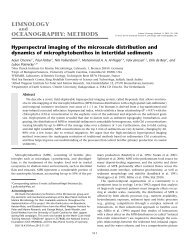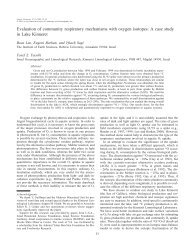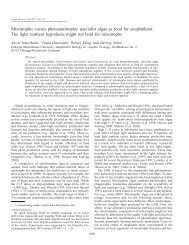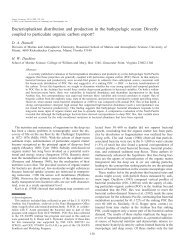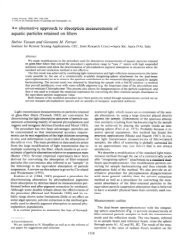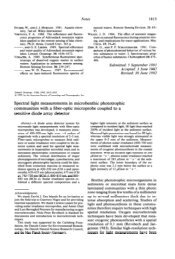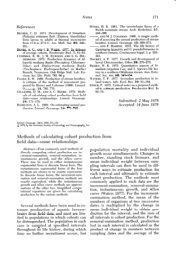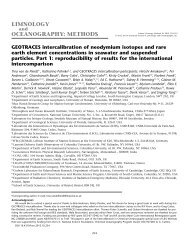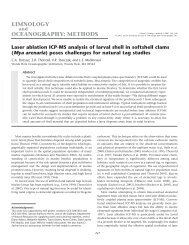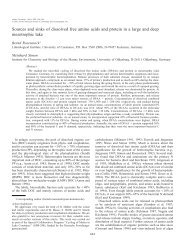Download - ASLO
Download - ASLO
Download - ASLO
You also want an ePaper? Increase the reach of your titles
YUMPU automatically turns print PDFs into web optimized ePapers that Google loves.
1776<br />
Notes<br />
1000<br />
500<br />
< 200<br />
p 100<br />
7<br />
f 50<br />
3 Tap. ’<br />
v 20 30<br />
0 32 30<br />
b 40 “/.o<br />
0.5<br />
e- 0.4<br />
B<br />
z- 0.3<br />
P<br />
E<br />
6<br />
z<br />
0.2<br />
0 Baker (Tap, 30.3YZ)<br />
A EMS (Tap, 30.5’C)<br />
20<br />
f 0.1<br />
10<br />
200 500 1000 2000 5000 lE4 2E4 5E4 lE5<br />
Fig. 9. Comparison of clod card data with the equation<br />
of Pastemak and Gauvin (1960) for spheres (dashed line)<br />
and the equation for a flat plate (Skelland 1974), represented<br />
by the dotted line. The data of Glenn and Doty<br />
(1992) for 32960 seawater are shown, but were not used in<br />
obtaining Eq. 12. The points below iVRe = 1,000 are increased<br />
by natural convection and were also omitted from<br />
the correlation.<br />
NRI?<br />
rienced problems of variability of weight loss<br />
under uniform conditions by clod cards from<br />
the same batch. Referring to Fig. 2, the variability<br />
of clod card weight loss in our tests can<br />
be estimated by comparing the loss from<br />
matched pairs of cards at the same radial position<br />
on the arm (1, 2, 3, . . .) but on opposite<br />
sides of the arm. For all of our runs with<br />
EM Science plaster of paris at the different temperatures,<br />
salinities, and speeds, the standard<br />
deviation of the weight loss differences, as<br />
[CA w/KLIe* - (A IV/ WJsideZ], was 0.0135,<br />
while the overall average difference was 7.7 x<br />
10m4 (n = 60), which is not significantly different<br />
from zero (P = 0.05). Extreme variability<br />
of weight loss within a batch of cards<br />
caused no problems during our tests.<br />
We also ran limited tests with plaster of paris<br />
from Sargent-Welsh Chemical Co. (technical<br />
grade) and from Baker Scientific Co. (reagent,<br />
extra-fine powder ~44 pm, suitable for electrophoresis<br />
gel). The Sargent-Welsh material<br />
produced clod cards of the same density as the<br />
EM Science material used throughout these<br />
tests; a slight excess of water (375 ml : 500 g)<br />
used with the Sargent-Welsh plaster also failed<br />
to alter the final density. There was no significant<br />
difference between the dissolution rates<br />
of cards made with the Sargent-Welsh plaster<br />
and those made with EM Science material when<br />
tested under the same conditions. The cards<br />
made with plaster from Baker Scientific are of<br />
more interest because of their higher density:<br />
6 6 10 12<br />
Velocity, cm s -’<br />
2 5 1U LO<br />
Velocity, cm s -’<br />
Fig. 10. Effect of clod card density on dissolution rates.<br />
Cards made from reagent-grade plaster of paris from Baker<br />
had densities 50% higher than cards made with material<br />
from EMS. Upper plot illustrates differences in dissolution<br />
rates between the two batches, while the slopes of the lines<br />
in the lower plot of the same data, adjusted by the term<br />
Wi/Ai, are not significantly different (P > 0.05). Points<br />
below V = 2 cm s-l, influenced by free convection, were<br />
omitted from the analysis.<br />
1.8 g cm-3 as opposed to 1.2 for our standard<br />
EM Science material. High density cards are<br />
likely to be preferable for fieldwork because<br />
they take longer to dissolve than lower density<br />
cards of the same volume, and they tend to be<br />
stronger and less likely to be accidentally broken<br />
or chipped during handling. Figure 10 indicates<br />
that Eq. 8 holds for both high- and lowdensity<br />
cards when the proper values Of Ai/ Wi<br />
(1.38 for EMS and 0.92 cm* g-l for Baker) are<br />
used. Despite these results, one should use caution<br />
in changing the source or grade of plaster<br />
of paris; materials are occasionally added to<br />
building-grade material to lower the solubility<br />
and enhance water resistance.<br />
In addition to the rotating arm method for<br />
calibrating clod cards, we also wanted to pursue<br />
Doty’s (1971) and Howerton and Boyd’s<br />
(1992) suggestions for a free-convention meth-




